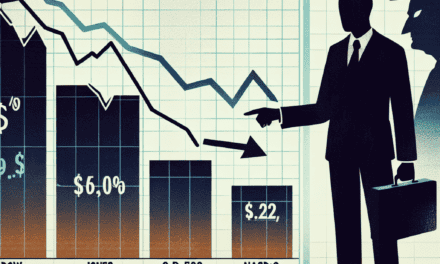“Markets on Edge: Dollar Braces for Election Day Shockwaves”
Introduction
As the United States approaches another pivotal election day, financial markets and the U.S. dollar are poised for potential volatility and uncertainty. Historically, elections have been significant events that can influence market dynamics, investor sentiment, and currency valuations. The anticipation of policy shifts, changes in government leadership, and the potential for legislative gridlock or reform can lead to fluctuations in stock prices, bond yields, and foreign exchange rates. Market participants closely monitor polling data, campaign developments, and geopolitical factors to gauge the possible outcomes and their implications for economic policy and international trade. As election day nears, the financial landscape is marked by heightened sensitivity to news and events, with investors bracing for the impact of electoral results on the economic outlook and market stability.
Impact Of US Elections On Global Markets
As the United States approaches another pivotal election day, global markets and the value of the US dollar are poised for potential volatility. Historically, US elections have had significant impacts on financial markets worldwide, and this year is no exception. Investors and analysts alike are closely monitoring the political landscape, as the outcome could influence economic policies, trade agreements, and international relations, all of which have far-reaching implications for global markets.
In the lead-up to the election, uncertainty often reigns supreme, causing fluctuations in market sentiment. Investors tend to adopt a cautious approach, leading to increased market volatility. This is primarily because the policies of the incoming administration can significantly alter the economic environment. For instance, changes in tax policies, government spending, and regulatory frameworks can either bolster or hinder economic growth, thereby affecting investor confidence. Consequently, stock markets may experience heightened volatility as traders attempt to anticipate the election’s outcome and its subsequent impact on various sectors.
Moreover, the US dollar, a cornerstone of global finance, is also susceptible to election-induced fluctuations. The dollar’s value is influenced by a myriad of factors, including interest rates, inflation expectations, and geopolitical stability. Elections can introduce uncertainty into these areas, prompting investors to reassess their positions. A potential shift in monetary policy, for example, could lead to changes in interest rates, which in turn affect the dollar’s strength. Additionally, the election outcome could impact international trade policies, influencing the dollar’s exchange rates with other currencies.
Transitioning to the global perspective, the interconnectedness of today’s financial markets means that the effects of US elections are not confined to domestic borders. International investors often view the US as a bellwether for global economic health, and any significant political changes can ripple through global markets. For instance, a shift in US trade policy could alter the dynamics of international trade, affecting economies that are heavily reliant on exports to the US. Similarly, changes in US foreign policy could impact geopolitical stability, influencing investor sentiment worldwide.
Furthermore, emerging markets are particularly sensitive to changes in US economic policy. These markets often rely on foreign investment, and any perceived instability in the US can lead to capital outflows, exacerbating economic challenges. Conversely, a stable and predictable US political environment can attract investment, providing a boost to these economies. Therefore, the stakes are high for emerging markets as they closely watch the US election unfold.
In conclusion, as election day approaches, global markets and the US dollar brace for potential impacts stemming from the political transition. The uncertainty surrounding the election outcome and its implications for economic policy can lead to increased market volatility. Investors worldwide are keenly aware of the interconnected nature of today’s financial systems, understanding that changes in the US political landscape can have profound effects on global markets. As such, they remain vigilant, ready to adapt their strategies in response to the evolving political and economic environment. The coming weeks will undoubtedly be a critical period for market participants as they navigate the complexities of the US election and its global ramifications.
Dollar Volatility In The Face Of Political Uncertainty
As the United States approaches another pivotal election day, the financial markets and the U.S. dollar are bracing for potential volatility, a common occurrence during periods of political uncertainty. Historically, elections have been a significant source of market fluctuations, as investors attempt to anticipate the economic policies that may follow a change in administration or a shift in congressional power. This year is no exception, with the stakes particularly high given the current global economic climate and domestic challenges.
The U.S. dollar, a cornerstone of global finance, often experiences heightened volatility in the lead-up to elections. This is primarily due to the currency’s role as a safe-haven asset, which can lead to increased demand during times of uncertainty. However, the dollar’s value is also influenced by expectations regarding future fiscal and monetary policies, which are closely tied to the political landscape. As candidates outline their economic agendas, investors scrutinize these plans to gauge their potential impact on inflation, interest rates, and overall economic growth.
In the current election cycle, several key issues are at the forefront, including inflation control, fiscal stimulus measures, and international trade policies. Each of these factors can significantly influence the dollar’s trajectory. For instance, a candidate advocating for substantial fiscal stimulus might lead to concerns about increased government debt and inflationary pressures, potentially weakening the dollar. Conversely, a focus on tightening monetary policy to combat inflation could bolster the currency by attracting foreign investment seeking higher returns.
Moreover, the global context cannot be ignored. The U.S. dollar’s performance is not only a reflection of domestic policies but also of international economic conditions. As the world continues to recover from the disruptions caused by the COVID-19 pandemic, supply chain issues, and geopolitical tensions, the dollar’s role as a global reserve currency remains crucial. Investors worldwide are closely monitoring the U.S. election, as its outcome could have far-reaching implications for international trade agreements and diplomatic relations.
In addition to these economic considerations, market participants are also wary of potential election-related disruptions. The possibility of contested results or delays in vote counting could exacerbate market volatility, as uncertainty over the political outcome may lead to risk-averse behavior among investors. In such scenarios, the dollar might experience sharp movements as traders seek to hedge against potential risks.
To navigate this period of uncertainty, financial analysts and investors are employing various strategies to mitigate potential risks. Diversification across asset classes and geographic regions is one approach, allowing investors to spread their exposure and reduce reliance on any single market or currency. Additionally, the use of hedging instruments, such as options and futures contracts, can provide a buffer against adverse currency movements.
As election day draws nearer, the interplay between political developments and market dynamics will continue to be a focal point for investors. While the outcome remains uncertain, the anticipation of potential policy shifts and their economic implications will undoubtedly keep the dollar and financial markets on edge. In this environment, staying informed and adaptable will be key for those looking to navigate the complexities of the financial landscape during this critical period.
Historical Market Trends During US Election Years
As the United States approaches another pivotal election day, both domestic and international markets are bracing for potential volatility, a phenomenon that has been historically observed during US election years. The anticipation of political change often leads to uncertainty, which in turn affects investor behavior and market dynamics. Historically, election years have been marked by fluctuations in stock markets, currency valuations, and investor sentiment, as market participants attempt to predict the outcomes and their subsequent economic implications.
To understand the potential impact of the upcoming election, it is essential to examine historical market trends during previous US election years. Traditionally, the months leading up to an election are characterized by increased market volatility. This is largely due to the uncertainty surrounding potential policy changes that could arise from a new administration. Investors often react to the perceived economic policies of the candidates, which can lead to shifts in market sentiment and asset allocation. For instance, if a candidate is perceived as business-friendly, markets may react positively, anticipating favorable economic policies. Conversely, if a candidate is viewed as likely to implement stringent regulations, markets may respond with caution.
Moreover, the US dollar, a critical component of global financial markets, often experiences fluctuations during election years. The dollar’s value is influenced by a myriad of factors, including interest rates, economic growth prospects, and geopolitical stability. During election years, the uncertainty surrounding future economic policies can lead to increased volatility in the dollar’s value. Investors may seek safe-haven assets or diversify their portfolios to hedge against potential risks, impacting the dollar’s strength relative to other currencies.
In addition to these factors, historical data suggests that the stock market’s performance in the months leading up to an election can be indicative of the election’s outcome. The so-called “presidential election cycle theory” posits that stock market performance in the months preceding an election can influence voter sentiment and, consequently, the election results. While this theory is not foolproof, it highlights the intricate relationship between market performance and political outcomes.
Furthermore, it is important to consider the role of external factors that can exacerbate market volatility during election years. Global economic conditions, geopolitical tensions, and unforeseen events such as natural disasters or pandemics can all contribute to market instability. These factors, combined with the inherent uncertainty of an election year, create a complex environment for investors to navigate.
As election day approaches, market participants will closely monitor political developments, economic indicators, and corporate earnings reports to gauge the potential impact on their investment strategies. While historical trends provide valuable insights, each election year presents unique challenges and opportunities. Therefore, investors must remain vigilant and adaptable, ready to respond to the dynamic landscape that characterizes election years.
In conclusion, the approach of US election day brings with it a heightened sense of anticipation and uncertainty in financial markets. Historical trends suggest that market volatility is a common feature of election years, driven by the potential for significant policy changes and the resulting economic implications. As investors brace for impact, they must consider both historical patterns and current conditions to make informed decisions in an ever-evolving market environment.
Investor Strategies For Navigating Election-Induced Market Fluctuations

As the United States approaches another pivotal election day, investors worldwide are bracing for the potential market fluctuations that often accompany such significant political events. Historically, elections have been periods of heightened uncertainty, with markets reacting to the anticipated and actual outcomes. This year is no exception, as the stakes are high and the economic landscape is complex. Consequently, investors are seeking strategies to navigate the potential volatility and protect their portfolios from adverse impacts.
One of the primary concerns for investors during election periods is the uncertainty surrounding policy changes. Different administrations bring varying economic policies, which can significantly impact sectors such as healthcare, energy, and technology. Investors often attempt to predict which sectors might benefit or suffer based on the potential election outcomes. However, this approach can be fraught with challenges, as political campaigns may not always translate into actionable policies. Therefore, diversification remains a key strategy. By spreading investments across a range of sectors and asset classes, investors can mitigate the risks associated with any single policy shift.
In addition to diversification, maintaining a long-term perspective is crucial. While short-term market fluctuations can be unsettling, historical data suggests that markets tend to stabilize over time, regardless of the election outcome. Investors who focus on long-term goals and resist the urge to make impulsive decisions based on election-related news are often better positioned to weather the storm. This approach requires discipline and a clear understanding of one’s investment objectives, but it can provide a buffer against the emotional reactions that volatile markets can provoke.
Moreover, the role of the US dollar in the global economy cannot be overlooked. Election outcomes can influence the dollar’s strength, as they often affect international trade policies and economic relations. A strong dollar can impact multinational companies by making their exports more expensive, while a weaker dollar can have the opposite effect. Investors with international exposure should consider currency hedging strategies to protect against potential fluctuations in the dollar’s value. This can involve using financial instruments such as futures contracts or options to offset potential losses from currency movements.
Furthermore, it is essential for investors to stay informed and adaptable. The political landscape can change rapidly, and being aware of the latest developments can help investors make informed decisions. This does not mean reacting to every piece of news, but rather understanding the broader implications of policy proposals and election results. Engaging with financial advisors and leveraging their expertise can also provide valuable insights and guidance during these uncertain times.
In conclusion, as the US election day approaches, investors are faced with the challenge of navigating potential market fluctuations. By employing strategies such as diversification, maintaining a long-term perspective, considering currency hedging, and staying informed, investors can better position themselves to manage the uncertainties that elections bring. While the political climate may be unpredictable, a well-thought-out investment strategy can provide stability and confidence in the face of market volatility. As always, the key is to remain focused on long-term objectives and to avoid making hasty decisions based on short-term market movements.
The Role Of The Federal Reserve Amid Election Turbulence
As the United States approaches another pivotal election day, the financial markets and the value of the dollar are poised for potential volatility. This period of uncertainty is not unfamiliar to investors and policymakers, who often brace for the impact of political shifts on economic stability. Central to navigating this turbulence is the role of the Federal Reserve, which stands as a pillar of economic guidance and stability amid the unpredictable nature of electoral outcomes.
The Federal Reserve, as the central bank of the United States, plays a crucial role in maintaining economic equilibrium, particularly during times of political uncertainty. Its primary tools—monetary policy adjustments, interest rate decisions, and open market operations—are designed to manage inflation, maximize employment, and stabilize the financial system. As election day nears, the Fed’s actions are closely scrutinized, as they can significantly influence market sentiment and investor confidence.
In the lead-up to an election, the Federal Reserve often finds itself in a delicate position. On one hand, it must remain apolitical and independent, ensuring that its decisions are based on economic data rather than political pressures. On the other hand, the Fed must be responsive to the economic conditions that may arise from electoral uncertainty. This balancing act requires a careful assessment of the economic landscape, including potential risks such as market volatility, shifts in fiscal policy, and changes in international trade relations.
One of the key challenges for the Federal Reserve during this period is managing interest rates. In times of uncertainty, investors may seek safe-haven assets, leading to fluctuations in bond yields and currency values. The Fed’s interest rate decisions can either mitigate or exacerbate these movements. For instance, a decision to lower interest rates might stimulate economic activity and reassure markets, but it could also lead to concerns about inflationary pressures. Conversely, maintaining or raising rates might strengthen the dollar but could dampen economic growth.
Moreover, the Federal Reserve’s communication strategy becomes particularly important as election day approaches. Clear and transparent communication can help manage market expectations and reduce uncertainty. By providing guidance on its policy outlook and economic assessments, the Fed can offer a degree of predictability that is often lacking during election cycles. This transparency is vital in maintaining investor confidence and ensuring that markets remain orderly.
In addition to domestic considerations, the Federal Reserve must also be mindful of the global economic environment. The interconnectedness of global markets means that U.S. elections can have far-reaching implications. The Fed’s policies can influence international capital flows, exchange rates, and global economic stability. As such, the Fed must consider the potential international ramifications of its actions, particularly in a world where geopolitical tensions and trade disputes are prevalent.
In conclusion, as the U.S. election day approaches, the Federal Reserve’s role becomes increasingly significant in navigating the economic uncertainties that accompany political transitions. Through its monetary policy tools, interest rate decisions, and communication strategies, the Fed seeks to maintain economic stability and instill confidence in the financial markets. While the path forward may be fraught with challenges, the Federal Reserve’s commitment to its mandate provides a steadying influence amid the electoral turbulence. As investors and policymakers brace for impact, the Fed’s actions will undoubtedly play a pivotal role in shaping the economic landscape in the weeks and months to come.
Currency Markets And The US Election: What To Expect
As the United States approaches another pivotal election day, the currency markets are bracing for potential volatility, with the US dollar at the center of attention. Historically, US elections have had significant impacts on financial markets, and this year is no exception. Investors and analysts are closely monitoring the political landscape, as the outcome could have far-reaching implications for economic policy, trade relations, and fiscal strategies. Consequently, the currency markets are poised for fluctuations, with the dollar’s value likely to be influenced by the election’s results.
In the lead-up to the election, market participants are keenly aware of the uncertainty that surrounds such a significant political event. This uncertainty often leads to increased market volatility, as traders and investors attempt to hedge against potential risks. The US dollar, being a global reserve currency, is particularly sensitive to changes in investor sentiment. As a result, any shifts in political power or policy direction can lead to rapid movements in the dollar’s value. For instance, a change in administration could signal a shift in economic priorities, such as tax policies or government spending, which in turn could affect the dollar’s strength.
Moreover, the election’s outcome could have implications for the Federal Reserve’s monetary policy. The central bank’s approach to interest rates and quantitative easing is closely tied to the government’s fiscal policies. A new administration might advocate for different economic strategies, potentially influencing the Fed’s decisions. This interplay between fiscal and monetary policy is crucial for currency markets, as it affects inflation expectations and interest rate differentials, both of which are key drivers of currency values.
In addition to domestic factors, international considerations also play a significant role in shaping the currency markets during the US election period. Trade relations, particularly with major partners such as China and the European Union, are often a focal point of electoral debates. Changes in trade policies can have immediate effects on the dollar, as they impact the balance of trade and investor confidence. For example, a more protectionist stance could lead to concerns about global trade tensions, potentially weakening the dollar as investors seek safer assets.
Furthermore, geopolitical stability is another factor that currency markets consider during election times. The US’s role on the global stage can influence perceptions of risk and stability, affecting the dollar’s appeal as a safe-haven currency. Any shifts in foreign policy or international alliances could alter these perceptions, leading to adjustments in currency valuations.
As election day approaches, market participants are likely to adopt a cautious stance, with many opting for hedging strategies to mitigate potential risks. This cautious approach is reflected in the increased demand for options and other derivative instruments that provide protection against adverse currency movements. Additionally, investors may diversify their portfolios to reduce exposure to the dollar, seeking opportunities in other currencies or asset classes.
In conclusion, the US election is a critical event for currency markets, with the potential to cause significant fluctuations in the dollar’s value. As investors navigate this period of uncertainty, they must consider a range of factors, including domestic economic policies, international trade relations, and geopolitical stability. By understanding these dynamics, market participants can better prepare for the potential impacts of the election on the currency markets, ensuring they are well-positioned to respond to any changes in the financial landscape.
Analyzing The Relationship Between Election Outcomes And Market Performance
As the United States approaches another pivotal election day, the financial markets and the value of the dollar are poised for potential volatility. Historically, election outcomes have had a significant impact on market performance, with investors closely monitoring the political landscape to anticipate shifts in economic policy. The relationship between election results and market behavior is complex, influenced by a myriad of factors including investor sentiment, policy expectations, and global economic conditions.
To begin with, it is essential to understand that markets generally dislike uncertainty. In the lead-up to an election, uncertainty tends to increase as investors grapple with the potential for significant policy changes. This uncertainty can lead to heightened market volatility, as traders and investors adjust their portfolios in anticipation of various electoral outcomes. For instance, if a candidate perceived as market-friendly is expected to win, markets may rally in anticipation of favorable economic policies. Conversely, if a candidate with policies perceived as less favorable to business is leading in the polls, markets may react negatively.
Moreover, the impact of election outcomes on the dollar is also noteworthy. The value of the dollar is influenced by a range of factors, including interest rates, inflation expectations, and overall economic stability. Elections can affect these factors by altering fiscal and monetary policy directions. For example, a government that prioritizes fiscal stimulus may lead to expectations of increased inflation, potentially weakening the dollar. On the other hand, a government focused on reducing deficits might strengthen the dollar by fostering confidence in the country’s fiscal health.
In addition to domestic factors, global economic conditions play a crucial role in shaping the relationship between election outcomes and market performance. The interconnectedness of global markets means that U.S. elections can have far-reaching implications beyond national borders. International investors closely watch U.S. elections, as changes in American policy can influence global trade, investment flows, and geopolitical stability. Consequently, the reaction of foreign markets to U.S. election results can further amplify the impact on the dollar and domestic markets.
Furthermore, it is important to consider the historical context when analyzing the relationship between election outcomes and market performance. While past performance is not always indicative of future results, historical trends can provide valuable insights. For instance, research has shown that markets tend to perform better in the year following a presidential election, regardless of which party wins. This phenomenon, often referred to as the “presidential election cycle theory,” suggests that markets may benefit from reduced uncertainty and the implementation of new policies.
However, it is crucial to recognize that each election is unique, with its own set of circumstances and challenges. The current political climate, economic conditions, and global events all contribute to the complexity of predicting market reactions to election outcomes. As such, investors must remain vigilant and adaptable, carefully considering the potential implications of various electoral scenarios.
In conclusion, as U.S. election day approaches, both markets and the dollar are bracing for potential impacts. The relationship between election outcomes and market performance is multifaceted, influenced by factors such as investor sentiment, policy expectations, and global economic conditions. While historical trends can offer some guidance, the unique nature of each election necessitates a cautious and informed approach. Investors must navigate this period of uncertainty with a keen eye on both domestic and international developments, ready to adjust their strategies as the political landscape unfolds.
Q&A
1. **How do markets typically react as US Election Day approaches?**
Markets often experience increased volatility and uncertainty as investors try to anticipate the election outcome and its potential impact on economic policies.
2. **What impact does the US election have on the US dollar?**
The US dollar may fluctuate based on investor sentiment and expectations regarding future fiscal and monetary policies that could be implemented by the incoming administration.
3. **Why is there increased market volatility around election time?**
Uncertainty about the election outcome and potential policy changes can lead to fluctuations in investor confidence, causing increased buying and selling activity.
4. **How do investors typically hedge against election-related risks?**
Investors might diversify their portfolios, increase holdings in safe-haven assets like gold, or use options and futures to hedge against potential market swings.
5. **What sectors are most affected by US elections?**
Sectors such as healthcare, energy, and finance can be significantly impacted due to potential regulatory changes depending on the election outcome.
6. **How do international markets react to US elections?**
International markets may also experience volatility, as the US election can influence global trade policies, economic growth prospects, and geopolitical relations.
7. **What role does fiscal policy play in market reactions to elections?**
Anticipated changes in fiscal policy, such as tax reforms or government spending, can influence market expectations and investor strategies, impacting market movements.
Conclusion
As the US Election Day approaches, markets and the dollar are bracing for potential volatility and uncertainty. Historically, elections can lead to fluctuations in financial markets due to the unpredictability of outcomes and their implications for economic policy. Investors often adjust their portfolios in anticipation of changes in fiscal policy, trade agreements, and regulatory environments that could arise from a new administration. The dollar may experience volatility as traders react to shifts in investor sentiment and potential changes in monetary policy. Overall, the period leading up to and immediately following the election is likely to be marked by heightened market sensitivity as participants navigate the evolving political landscape.





